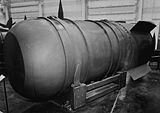- Mark 36 nuclear bomb
-
The Mark 36 was a heavy high-yield United States nuclear bomb designed in the 1950s. It was a thermonuclear bomb, using a multi-stage fusion secondary system to generate yields up to about 10 megatons. [1]
Contents
History
The Mark 36 was a more advanced version of the earlier Mark 21 nuclear bomb, which was a weaponized version of the "Shrimp" design, the first "dry" (lithium deuteride) fuel thermonuclear bomb the United States tested, in the Castle Bravo thermonuclear test in 1954.[2]
The Mark 21 bomb was developed and deployed immediately after Castle Bravo, in 1955. The Mark 21 design continued to be improved and the Mark 36 device started production in April 1956.[1] In 1957, all older Mark 21 bombs were converted to Mark 36 Y1 Mod 1 bombs. A total of 920 Mark 36 bombs were produced as new build or converted from the 275 Mark 21 bombs produced earlier.
All Mark 36 nuclear bombs were retired between August 1961 and January 1962, replaced by the higher yield B41 nuclear bomb
Survivors
A Mark 36 casing is on display in the Cold War Gallery at the National Museum of the United States Air Force in Dayton, Ohio.
A Mark 36 casing can be found at the Strategic Air and Space Museum near Ashland, Nebraska.
Specifications
The Mark 36 bomb was 56.2 to 59 inches in diameter, depending on version, and 150 inches long. It weighed 17,500 or 17,700 pounds depending on version.
There were 2 major variants, a "clean" and "dirty" variant. The clean variant used an inert fusion stage tamper-pusher assembly (see Teller-Ulam design#Tamper-pusher ablation ) such as lead or tungsten. The "dirty" variant used a Depleted Uranium or U-238 tamper-pusher which would undergo fission during the second stage fusion burn, doubling the weapon yield. The 9-10 megaton yield listed is for the "dirty" version - the "clean" version would have been roughly half that.
See also
References
- ^ a b "List of all US Nuclear Weapons". http://nuclearweaponarchive.org/Usa/Weapons/Allbombs.html. Retrieved 2008-05-02.
- ^ "Nuclear Weapon Archive". http://nuclearweaponarchive.org/Usa/Tests/Castle.html. Retrieved 2008-05-02.
Categories:- Cold War nuclear bombs of the United States
Wikimedia Foundation. 2010.

